Comprehensive Analysis of Business Resources at Marks and Spencer
VerifiedAdded on 2020/06/06
|9
|2646
|38
Report
AI Summary
This report provides a comprehensive analysis of the business resources utilized by Marks and Spencer. It begins with an examination of recruitment documentation, including job advertisements, descriptions, and person specifications, along with the employability, personal, and communication skills required for job applicants. The report then delves into the physical and technological resources essential for the company's operations, such as buildings, tills, computers, and software. Further, it explores the sources of internal and external finance available to Marks and Spencer, detailing the use of owner's savings, profits, bank loans, and government grants. The report includes interpretations of profit and loss accounts and balance sheets, illustrating the company's financial performance. It also examines the use of budgets for financial control, including allocated budgets and break-even analysis. Finally, the report evaluates the financial state of the business using key financial ratios such as gross margin, operating margin, and return on assets. The report is a detailed overview of the business resources of Marks and Spencer.
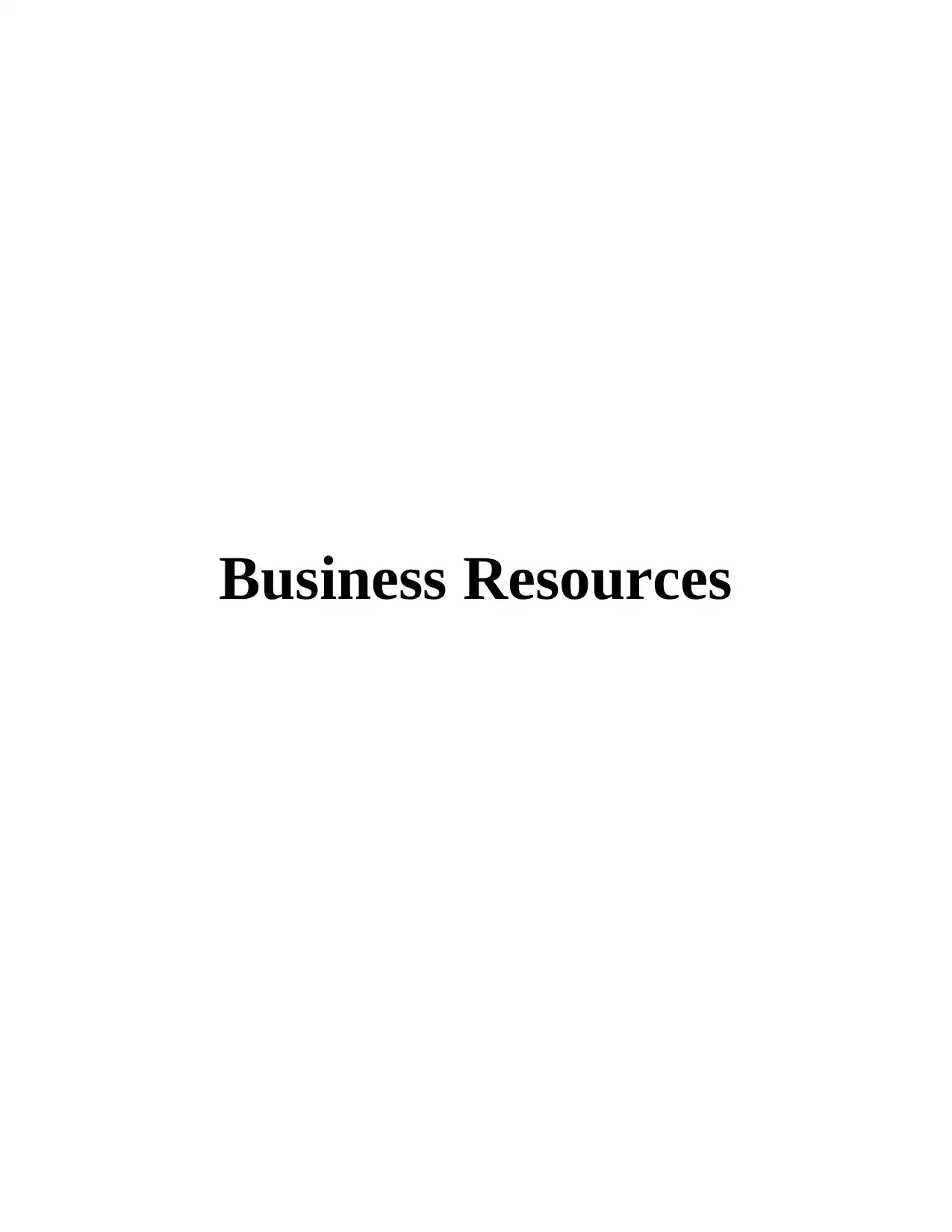
Business Resources
Paraphrase This Document
Need a fresh take? Get an instant paraphrase of this document with our AI Paraphraser
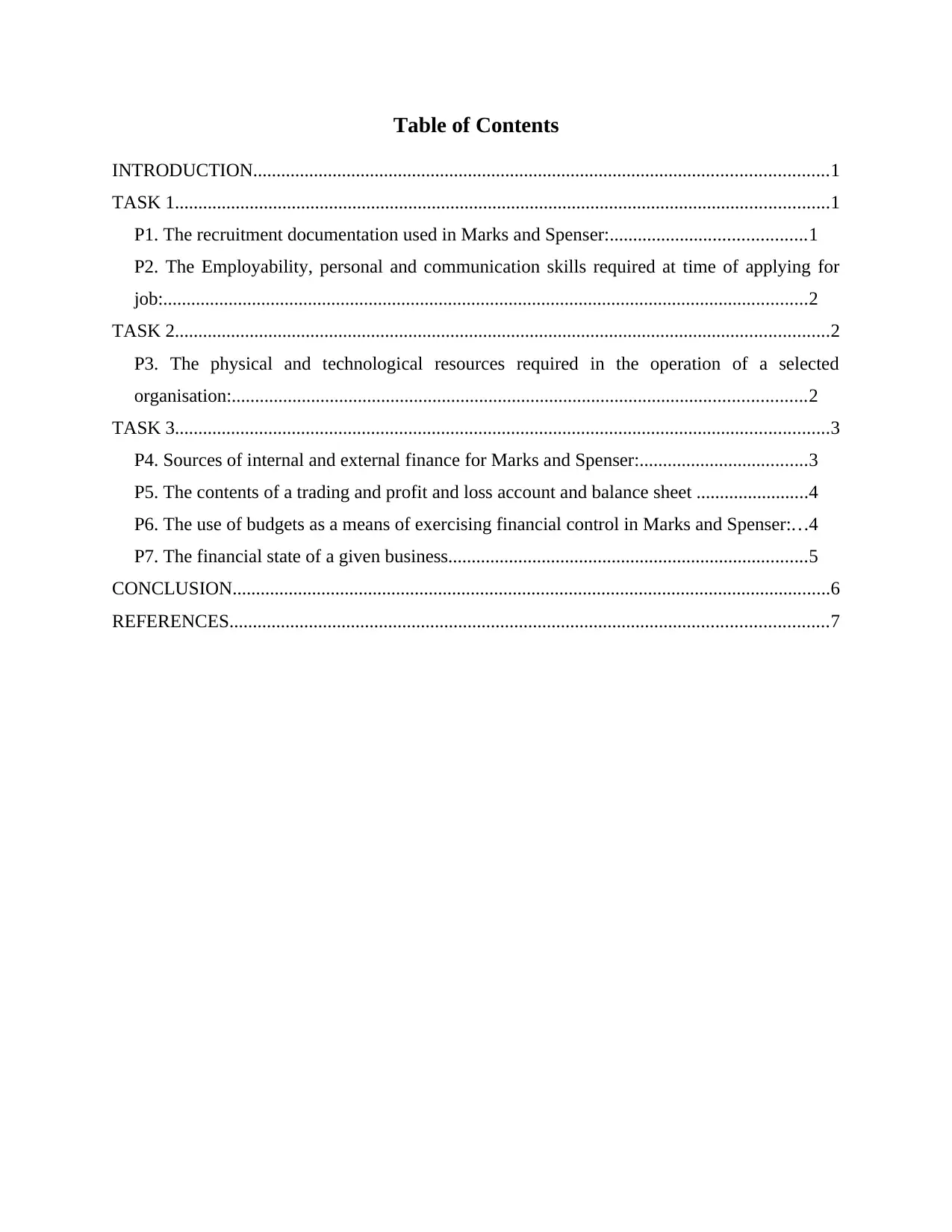
Table of Contents
INTRODUCTION...........................................................................................................................1
TASK 1............................................................................................................................................1
P1. The recruitment documentation used in Marks and Spenser:..........................................1
P2. The Employability, personal and communication skills required at time of applying for
job:..........................................................................................................................................2
TASK 2............................................................................................................................................2
P3. The physical and technological resources required in the operation of a selected
organisation:...........................................................................................................................2
TASK 3............................................................................................................................................3
P4. Sources of internal and external finance for Marks and Spenser:....................................3
P5. The contents of a trading and profit and loss account and balance sheet ........................4
P6. The use of budgets as a means of exercising financial control in Marks and Spenser:...4
P7. The financial state of a given business.............................................................................5
CONCLUSION................................................................................................................................6
REFERENCES................................................................................................................................7
INTRODUCTION...........................................................................................................................1
TASK 1............................................................................................................................................1
P1. The recruitment documentation used in Marks and Spenser:..........................................1
P2. The Employability, personal and communication skills required at time of applying for
job:..........................................................................................................................................2
TASK 2............................................................................................................................................2
P3. The physical and technological resources required in the operation of a selected
organisation:...........................................................................................................................2
TASK 3............................................................................................................................................3
P4. Sources of internal and external finance for Marks and Spenser:....................................3
P5. The contents of a trading and profit and loss account and balance sheet ........................4
P6. The use of budgets as a means of exercising financial control in Marks and Spenser:...4
P7. The financial state of a given business.............................................................................5
CONCLUSION................................................................................................................................6
REFERENCES................................................................................................................................7
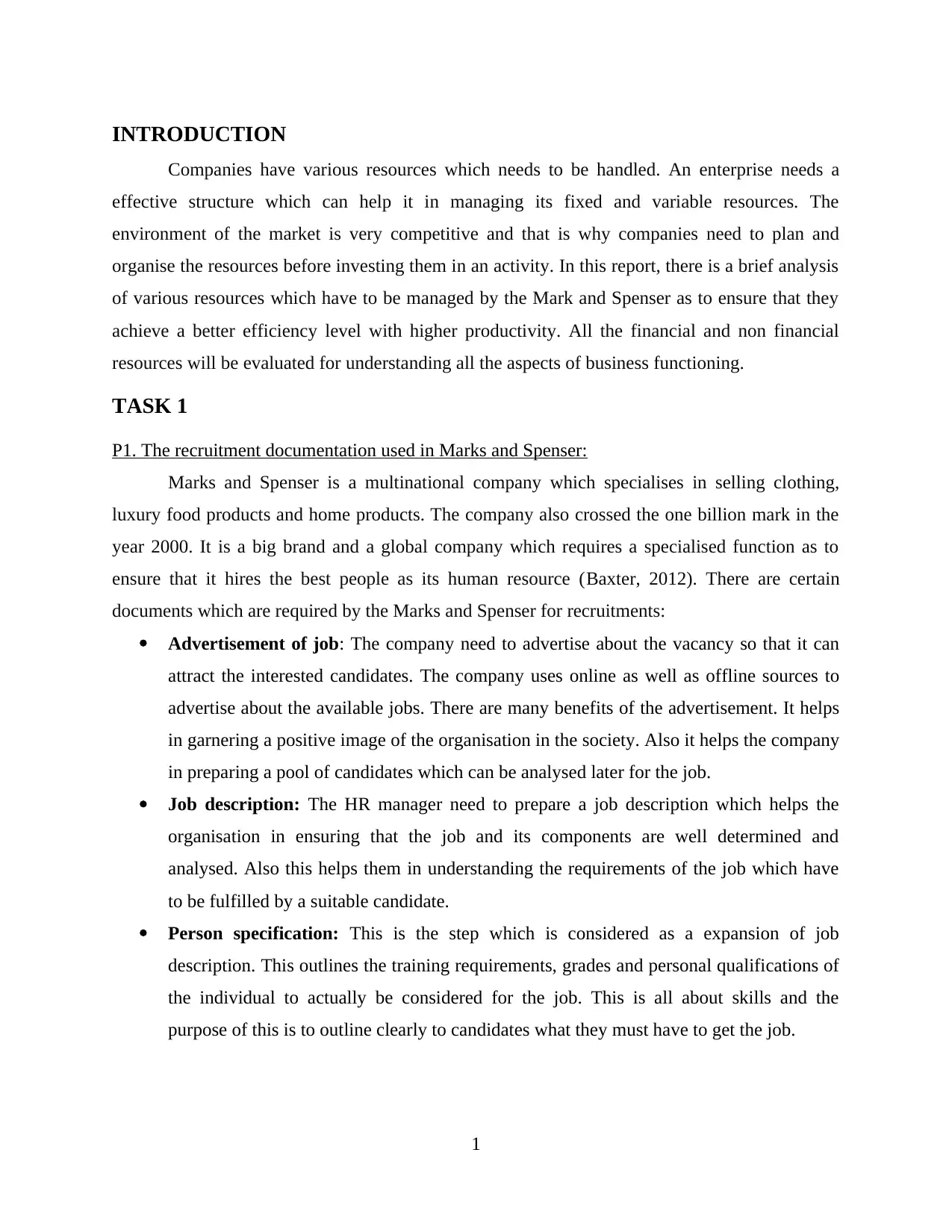
INTRODUCTION
Companies have various resources which needs to be handled. An enterprise needs a
effective structure which can help it in managing its fixed and variable resources. The
environment of the market is very competitive and that is why companies need to plan and
organise the resources before investing them in an activity. In this report, there is a brief analysis
of various resources which have to be managed by the Mark and Spenser as to ensure that they
achieve a better efficiency level with higher productivity. All the financial and non financial
resources will be evaluated for understanding all the aspects of business functioning.
TASK 1
P1. The recruitment documentation used in Marks and Spenser:
Marks and Spenser is a multinational company which specialises in selling clothing,
luxury food products and home products. The company also crossed the one billion mark in the
year 2000. It is a big brand and a global company which requires a specialised function as to
ensure that it hires the best people as its human resource (Baxter, 2012). There are certain
documents which are required by the Marks and Spenser for recruitments:
Advertisement of job: The company need to advertise about the vacancy so that it can
attract the interested candidates. The company uses online as well as offline sources to
advertise about the available jobs. There are many benefits of the advertisement. It helps
in garnering a positive image of the organisation in the society. Also it helps the company
in preparing a pool of candidates which can be analysed later for the job.
Job description: The HR manager need to prepare a job description which helps the
organisation in ensuring that the job and its components are well determined and
analysed. Also this helps them in understanding the requirements of the job which have
to be fulfilled by a suitable candidate.
Person specification: This is the step which is considered as a expansion of job
description. This outlines the training requirements, grades and personal qualifications of
the individual to actually be considered for the job. This is all about skills and the
purpose of this is to outline clearly to candidates what they must have to get the job.
1
Companies have various resources which needs to be handled. An enterprise needs a
effective structure which can help it in managing its fixed and variable resources. The
environment of the market is very competitive and that is why companies need to plan and
organise the resources before investing them in an activity. In this report, there is a brief analysis
of various resources which have to be managed by the Mark and Spenser as to ensure that they
achieve a better efficiency level with higher productivity. All the financial and non financial
resources will be evaluated for understanding all the aspects of business functioning.
TASK 1
P1. The recruitment documentation used in Marks and Spenser:
Marks and Spenser is a multinational company which specialises in selling clothing,
luxury food products and home products. The company also crossed the one billion mark in the
year 2000. It is a big brand and a global company which requires a specialised function as to
ensure that it hires the best people as its human resource (Baxter, 2012). There are certain
documents which are required by the Marks and Spenser for recruitments:
Advertisement of job: The company need to advertise about the vacancy so that it can
attract the interested candidates. The company uses online as well as offline sources to
advertise about the available jobs. There are many benefits of the advertisement. It helps
in garnering a positive image of the organisation in the society. Also it helps the company
in preparing a pool of candidates which can be analysed later for the job.
Job description: The HR manager need to prepare a job description which helps the
organisation in ensuring that the job and its components are well determined and
analysed. Also this helps them in understanding the requirements of the job which have
to be fulfilled by a suitable candidate.
Person specification: This is the step which is considered as a expansion of job
description. This outlines the training requirements, grades and personal qualifications of
the individual to actually be considered for the job. This is all about skills and the
purpose of this is to outline clearly to candidates what they must have to get the job.
1
⊘ This is a preview!⊘
Do you want full access?
Subscribe today to unlock all pages.

Trusted by 1+ million students worldwide
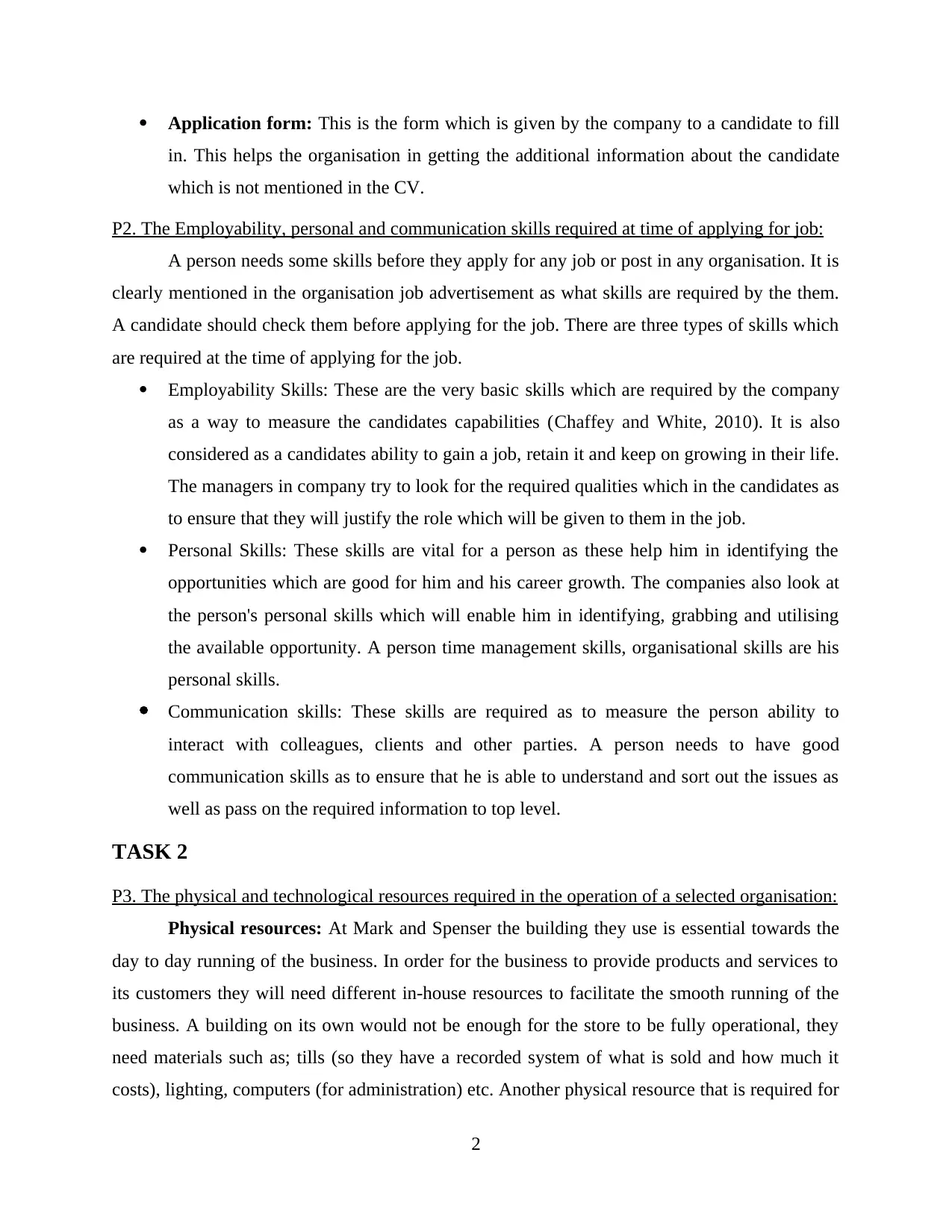
Application form: This is the form which is given by the company to a candidate to fill
in. This helps the organisation in getting the additional information about the candidate
which is not mentioned in the CV.
P2. The Employability, personal and communication skills required at time of applying for job:
A person needs some skills before they apply for any job or post in any organisation. It is
clearly mentioned in the organisation job advertisement as what skills are required by the them.
A candidate should check them before applying for the job. There are three types of skills which
are required at the time of applying for the job.
Employability Skills: These are the very basic skills which are required by the company
as a way to measure the candidates capabilities (Chaffey and White, 2010). It is also
considered as a candidates ability to gain a job, retain it and keep on growing in their life.
The managers in company try to look for the required qualities which in the candidates as
to ensure that they will justify the role which will be given to them in the job.
Personal Skills: These skills are vital for a person as these help him in identifying the
opportunities which are good for him and his career growth. The companies also look at
the person's personal skills which will enable him in identifying, grabbing and utilising
the available opportunity. A person time management skills, organisational skills are his
personal skills.
Communication skills: These skills are required as to measure the person ability to
interact with colleagues, clients and other parties. A person needs to have good
communication skills as to ensure that he is able to understand and sort out the issues as
well as pass on the required information to top level.
TASK 2
P3. The physical and technological resources required in the operation of a selected organisation:
Physical resources: At Mark and Spenser the building they use is essential towards the
day to day running of the business. In order for the business to provide products and services to
its customers they will need different in-house resources to facilitate the smooth running of the
business. A building on its own would not be enough for the store to be fully operational, they
need materials such as; tills (so they have a recorded system of what is sold and how much it
costs), lighting, computers (for administration) etc. Another physical resource that is required for
2
in. This helps the organisation in getting the additional information about the candidate
which is not mentioned in the CV.
P2. The Employability, personal and communication skills required at time of applying for job:
A person needs some skills before they apply for any job or post in any organisation. It is
clearly mentioned in the organisation job advertisement as what skills are required by the them.
A candidate should check them before applying for the job. There are three types of skills which
are required at the time of applying for the job.
Employability Skills: These are the very basic skills which are required by the company
as a way to measure the candidates capabilities (Chaffey and White, 2010). It is also
considered as a candidates ability to gain a job, retain it and keep on growing in their life.
The managers in company try to look for the required qualities which in the candidates as
to ensure that they will justify the role which will be given to them in the job.
Personal Skills: These skills are vital for a person as these help him in identifying the
opportunities which are good for him and his career growth. The companies also look at
the person's personal skills which will enable him in identifying, grabbing and utilising
the available opportunity. A person time management skills, organisational skills are his
personal skills.
Communication skills: These skills are required as to measure the person ability to
interact with colleagues, clients and other parties. A person needs to have good
communication skills as to ensure that he is able to understand and sort out the issues as
well as pass on the required information to top level.
TASK 2
P3. The physical and technological resources required in the operation of a selected organisation:
Physical resources: At Mark and Spenser the building they use is essential towards the
day to day running of the business. In order for the business to provide products and services to
its customers they will need different in-house resources to facilitate the smooth running of the
business. A building on its own would not be enough for the store to be fully operational, they
need materials such as; tills (so they have a recorded system of what is sold and how much it
costs), lighting, computers (for administration) etc. Another physical resource that is required for
2
Paraphrase This Document
Need a fresh take? Get an instant paraphrase of this document with our AI Paraphraser
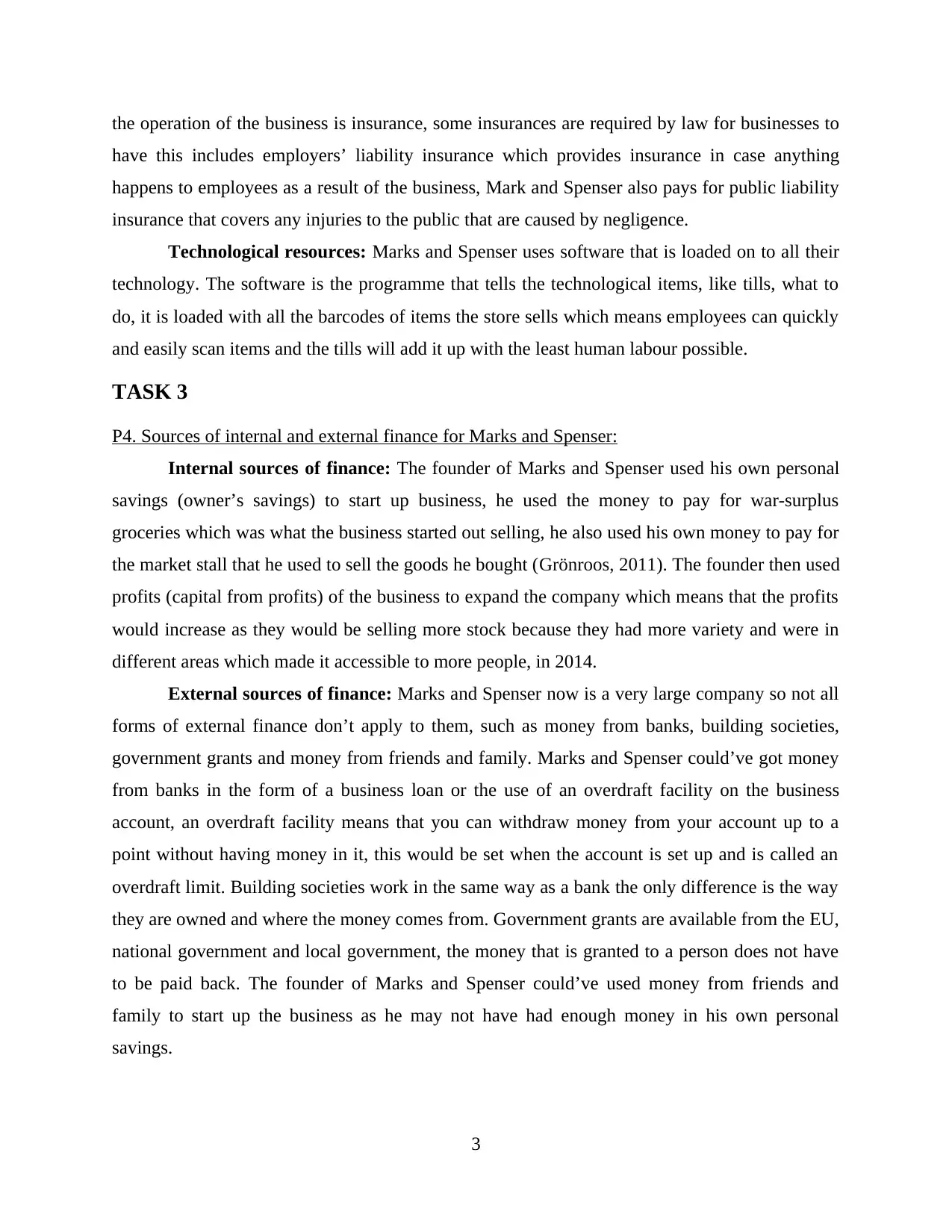
the operation of the business is insurance, some insurances are required by law for businesses to
have this includes employers’ liability insurance which provides insurance in case anything
happens to employees as a result of the business, Mark and Spenser also pays for public liability
insurance that covers any injuries to the public that are caused by negligence.
Technological resources: Marks and Spenser uses software that is loaded on to all their
technology. The software is the programme that tells the technological items, like tills, what to
do, it is loaded with all the barcodes of items the store sells which means employees can quickly
and easily scan items and the tills will add it up with the least human labour possible.
TASK 3
P4. Sources of internal and external finance for Marks and Spenser:
Internal sources of finance: The founder of Marks and Spenser used his own personal
savings (owner’s savings) to start up business, he used the money to pay for war-surplus
groceries which was what the business started out selling, he also used his own money to pay for
the market stall that he used to sell the goods he bought (Grönroos, 2011). The founder then used
profits (capital from profits) of the business to expand the company which means that the profits
would increase as they would be selling more stock because they had more variety and were in
different areas which made it accessible to more people, in 2014.
External sources of finance: Marks and Spenser now is a very large company so not all
forms of external finance don’t apply to them, such as money from banks, building societies,
government grants and money from friends and family. Marks and Spenser could’ve got money
from banks in the form of a business loan or the use of an overdraft facility on the business
account, an overdraft facility means that you can withdraw money from your account up to a
point without having money in it, this would be set when the account is set up and is called an
overdraft limit. Building societies work in the same way as a bank the only difference is the way
they are owned and where the money comes from. Government grants are available from the EU,
national government and local government, the money that is granted to a person does not have
to be paid back. The founder of Marks and Spenser could’ve used money from friends and
family to start up the business as he may not have had enough money in his own personal
savings.
3
have this includes employers’ liability insurance which provides insurance in case anything
happens to employees as a result of the business, Mark and Spenser also pays for public liability
insurance that covers any injuries to the public that are caused by negligence.
Technological resources: Marks and Spenser uses software that is loaded on to all their
technology. The software is the programme that tells the technological items, like tills, what to
do, it is loaded with all the barcodes of items the store sells which means employees can quickly
and easily scan items and the tills will add it up with the least human labour possible.
TASK 3
P4. Sources of internal and external finance for Marks and Spenser:
Internal sources of finance: The founder of Marks and Spenser used his own personal
savings (owner’s savings) to start up business, he used the money to pay for war-surplus
groceries which was what the business started out selling, he also used his own money to pay for
the market stall that he used to sell the goods he bought (Grönroos, 2011). The founder then used
profits (capital from profits) of the business to expand the company which means that the profits
would increase as they would be selling more stock because they had more variety and were in
different areas which made it accessible to more people, in 2014.
External sources of finance: Marks and Spenser now is a very large company so not all
forms of external finance don’t apply to them, such as money from banks, building societies,
government grants and money from friends and family. Marks and Spenser could’ve got money
from banks in the form of a business loan or the use of an overdraft facility on the business
account, an overdraft facility means that you can withdraw money from your account up to a
point without having money in it, this would be set when the account is set up and is called an
overdraft limit. Building societies work in the same way as a bank the only difference is the way
they are owned and where the money comes from. Government grants are available from the EU,
national government and local government, the money that is granted to a person does not have
to be paid back. The founder of Marks and Spenser could’ve used money from friends and
family to start up the business as he may not have had enough money in his own personal
savings.
3
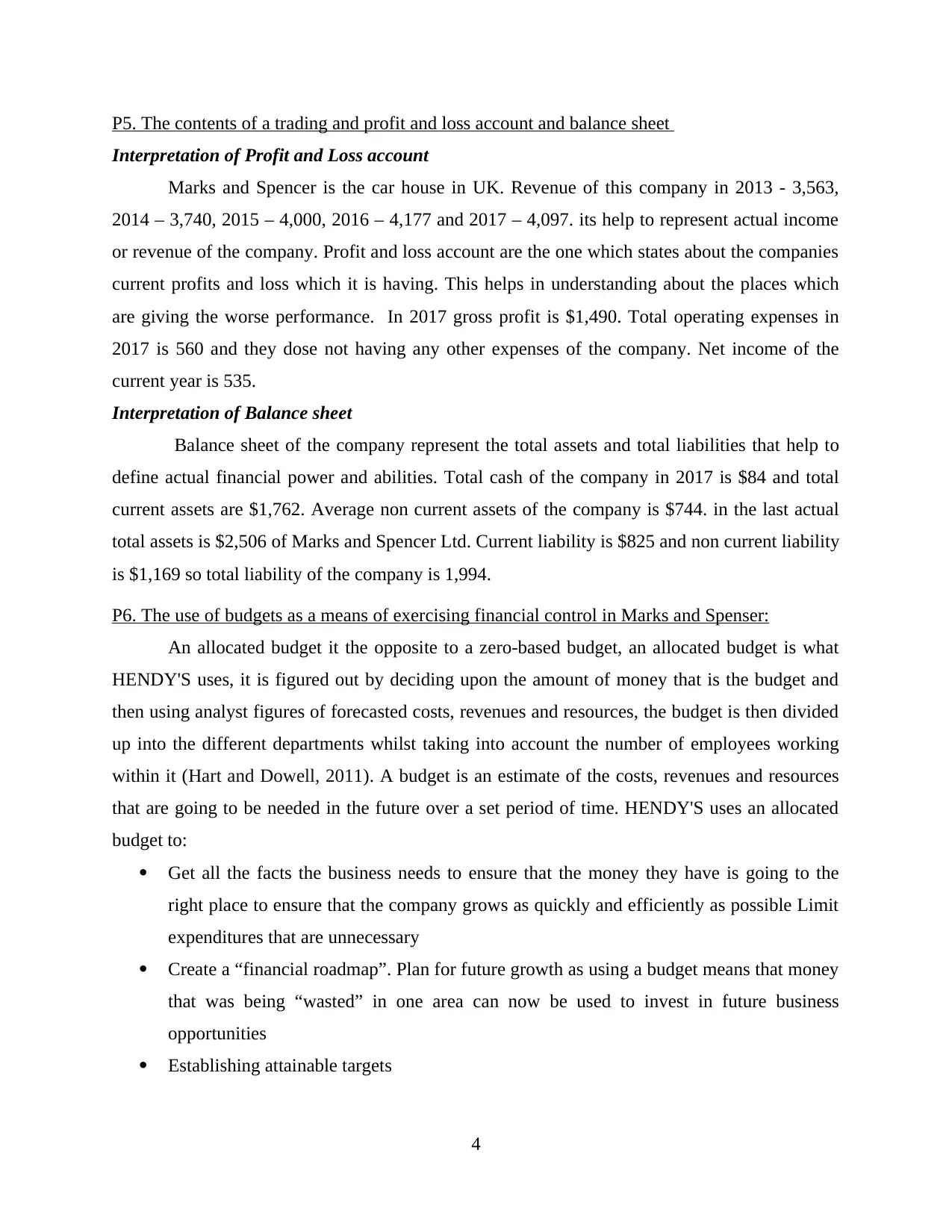
P5. The contents of a trading and profit and loss account and balance sheet
Interpretation of Profit and Loss account
Marks and Spencer is the car house in UK. Revenue of this company in 2013 - 3,563,
2014 – 3,740, 2015 – 4,000, 2016 – 4,177 and 2017 – 4,097. its help to represent actual income
or revenue of the company. Profit and loss account are the one which states about the companies
current profits and loss which it is having. This helps in understanding about the places which
are giving the worse performance. In 2017 gross profit is $1,490. Total operating expenses in
2017 is 560 and they dose not having any other expenses of the company. Net income of the
current year is 535.
Interpretation of Balance sheet
Balance sheet of the company represent the total assets and total liabilities that help to
define actual financial power and abilities. Total cash of the company in 2017 is $84 and total
current assets are $1,762. Average non current assets of the company is $744. in the last actual
total assets is $2,506 of Marks and Spencer Ltd. Current liability is $825 and non current liability
is $1,169 so total liability of the company is 1,994.
P6. The use of budgets as a means of exercising financial control in Marks and Spenser:
An allocated budget it the opposite to a zero-based budget, an allocated budget is what
HENDY'S uses, it is figured out by deciding upon the amount of money that is the budget and
then using analyst figures of forecasted costs, revenues and resources, the budget is then divided
up into the different departments whilst taking into account the number of employees working
within it (Hart and Dowell, 2011). A budget is an estimate of the costs, revenues and resources
that are going to be needed in the future over a set period of time. HENDY'S uses an allocated
budget to:
Get all the facts the business needs to ensure that the money they have is going to the
right place to ensure that the company grows as quickly and efficiently as possible Limit
expenditures that are unnecessary
Create a “financial roadmap”. Plan for future growth as using a budget means that money
that was being “wasted” in one area can now be used to invest in future business
opportunities
Establishing attainable targets
4
Interpretation of Profit and Loss account
Marks and Spencer is the car house in UK. Revenue of this company in 2013 - 3,563,
2014 – 3,740, 2015 – 4,000, 2016 – 4,177 and 2017 – 4,097. its help to represent actual income
or revenue of the company. Profit and loss account are the one which states about the companies
current profits and loss which it is having. This helps in understanding about the places which
are giving the worse performance. In 2017 gross profit is $1,490. Total operating expenses in
2017 is 560 and they dose not having any other expenses of the company. Net income of the
current year is 535.
Interpretation of Balance sheet
Balance sheet of the company represent the total assets and total liabilities that help to
define actual financial power and abilities. Total cash of the company in 2017 is $84 and total
current assets are $1,762. Average non current assets of the company is $744. in the last actual
total assets is $2,506 of Marks and Spencer Ltd. Current liability is $825 and non current liability
is $1,169 so total liability of the company is 1,994.
P6. The use of budgets as a means of exercising financial control in Marks and Spenser:
An allocated budget it the opposite to a zero-based budget, an allocated budget is what
HENDY'S uses, it is figured out by deciding upon the amount of money that is the budget and
then using analyst figures of forecasted costs, revenues and resources, the budget is then divided
up into the different departments whilst taking into account the number of employees working
within it (Hart and Dowell, 2011). A budget is an estimate of the costs, revenues and resources
that are going to be needed in the future over a set period of time. HENDY'S uses an allocated
budget to:
Get all the facts the business needs to ensure that the money they have is going to the
right place to ensure that the company grows as quickly and efficiently as possible Limit
expenditures that are unnecessary
Create a “financial roadmap”. Plan for future growth as using a budget means that money
that was being “wasted” in one area can now be used to invest in future business
opportunities
Establishing attainable targets
4
⊘ This is a preview!⊘
Do you want full access?
Subscribe today to unlock all pages.

Trusted by 1+ million students worldwide
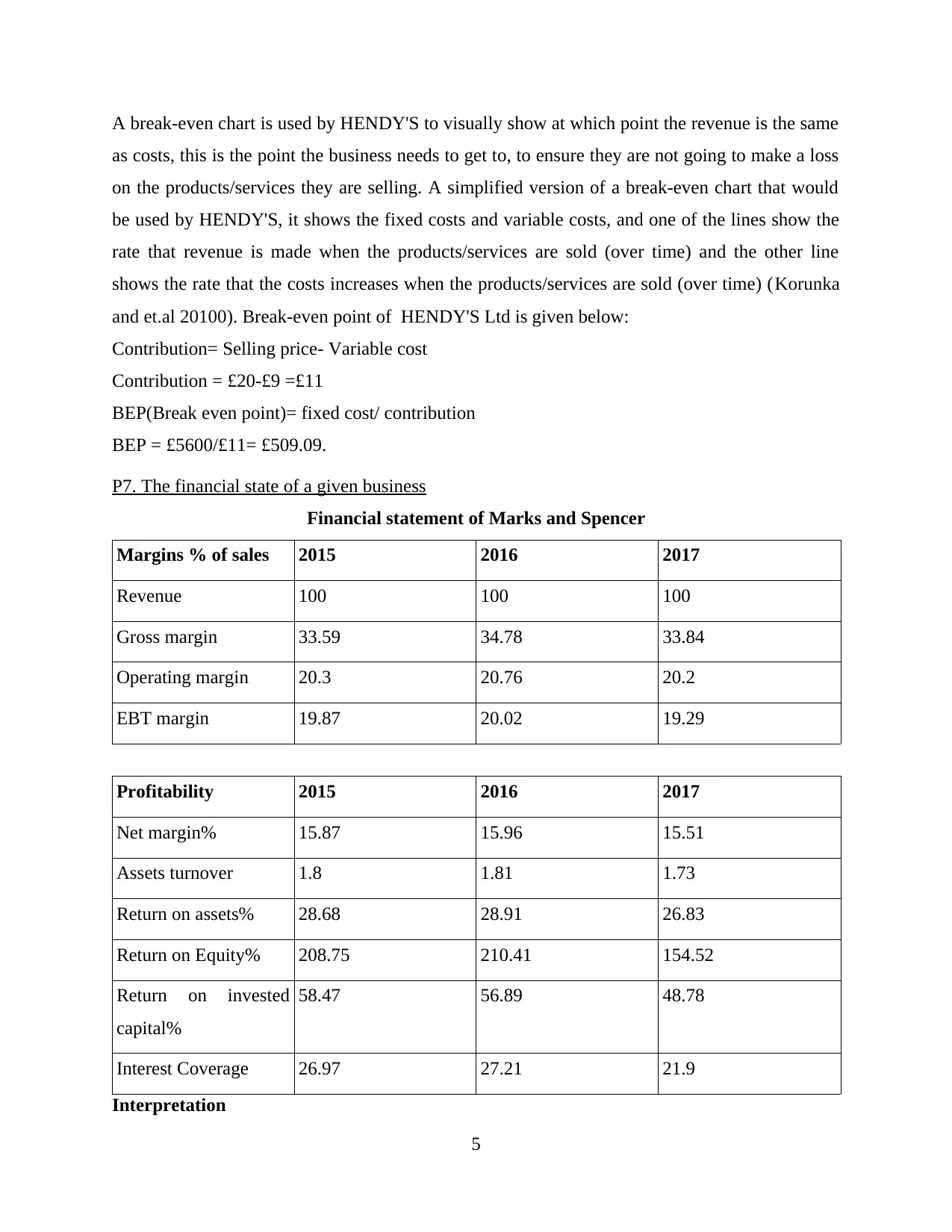
A break-even chart is used by HENDY'S to visually show at which point the revenue is the same
as costs, this is the point the business needs to get to, to ensure they are not going to make a loss
on the products/services they are selling. A simplified version of a break-even chart that would
be used by HENDY'S, it shows the fixed costs and variable costs, and one of the lines show the
rate that revenue is made when the products/services are sold (over time) and the other line
shows the rate that the costs increases when the products/services are sold (over time) (Korunka
and et.al 20100). Break-even point of HENDY'S Ltd is given below:
Contribution= Selling price- Variable cost
Contribution = £20-£9 =£11
BEP(Break even point)= fixed cost/ contribution
BEP = £5600/£11= £509.09.
P7. The financial state of a given business
Financial statement of Marks and Spencer
Margins % of sales 2015 2016 2017
Revenue 100 100 100
Gross margin 33.59 34.78 33.84
Operating margin 20.3 20.76 20.2
EBT margin 19.87 20.02 19.29
Profitability 2015 2016 2017
Net margin% 15.87 15.96 15.51
Assets turnover 1.8 1.81 1.73
Return on assets% 28.68 28.91 26.83
Return on Equity% 208.75 210.41 154.52
Return on invested
capital%
58.47 56.89 48.78
Interest Coverage 26.97 27.21 21.9
Interpretation
5
as costs, this is the point the business needs to get to, to ensure they are not going to make a loss
on the products/services they are selling. A simplified version of a break-even chart that would
be used by HENDY'S, it shows the fixed costs and variable costs, and one of the lines show the
rate that revenue is made when the products/services are sold (over time) and the other line
shows the rate that the costs increases when the products/services are sold (over time) (Korunka
and et.al 20100). Break-even point of HENDY'S Ltd is given below:
Contribution= Selling price- Variable cost
Contribution = £20-£9 =£11
BEP(Break even point)= fixed cost/ contribution
BEP = £5600/£11= £509.09.
P7. The financial state of a given business
Financial statement of Marks and Spencer
Margins % of sales 2015 2016 2017
Revenue 100 100 100
Gross margin 33.59 34.78 33.84
Operating margin 20.3 20.76 20.2
EBT margin 19.87 20.02 19.29
Profitability 2015 2016 2017
Net margin% 15.87 15.96 15.51
Assets turnover 1.8 1.81 1.73
Return on assets% 28.68 28.91 26.83
Return on Equity% 208.75 210.41 154.52
Return on invested
capital%
58.47 56.89 48.78
Interest Coverage 26.97 27.21 21.9
Interpretation
5
Paraphrase This Document
Need a fresh take? Get an instant paraphrase of this document with our AI Paraphraser
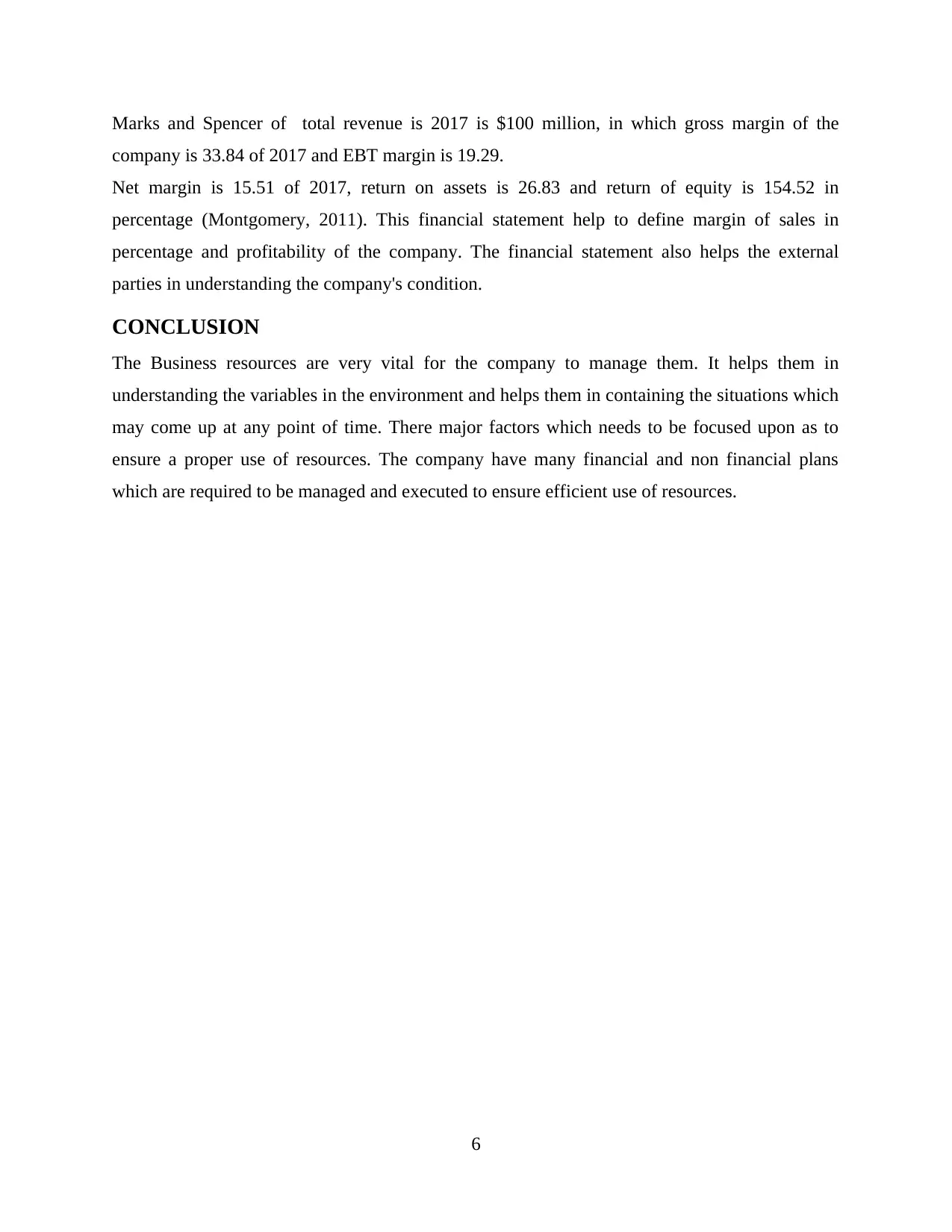
Marks and Spencer of total revenue is 2017 is $100 million, in which gross margin of the
company is 33.84 of 2017 and EBT margin is 19.29.
Net margin is 15.51 of 2017, return on assets is 26.83 and return of equity is 154.52 in
percentage (Montgomery, 2011). This financial statement help to define margin of sales in
percentage and profitability of the company. The financial statement also helps the external
parties in understanding the company's condition.
CONCLUSION
The Business resources are very vital for the company to manage them. It helps them in
understanding the variables in the environment and helps them in containing the situations which
may come up at any point of time. There major factors which needs to be focused upon as to
ensure a proper use of resources. The company have many financial and non financial plans
which are required to be managed and executed to ensure efficient use of resources.
6
company is 33.84 of 2017 and EBT margin is 19.29.
Net margin is 15.51 of 2017, return on assets is 26.83 and return of equity is 154.52 in
percentage (Montgomery, 2011). This financial statement help to define margin of sales in
percentage and profitability of the company. The financial statement also helps the external
parties in understanding the company's condition.
CONCLUSION
The Business resources are very vital for the company to manage them. It helps them in
understanding the variables in the environment and helps them in containing the situations which
may come up at any point of time. There major factors which needs to be focused upon as to
ensure a proper use of resources. The company have many financial and non financial plans
which are required to be managed and executed to ensure efficient use of resources.
6
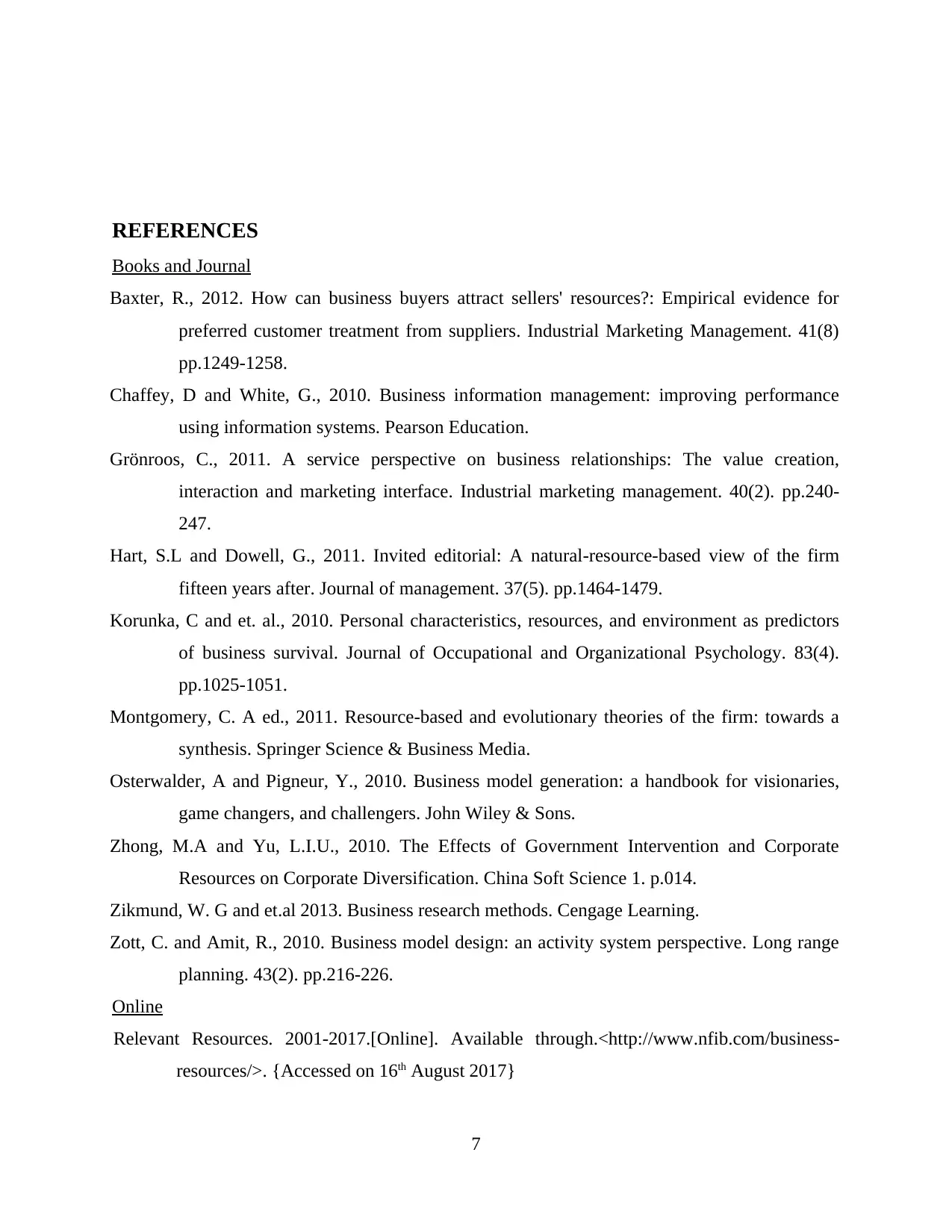
REFERENCES
Books and Journal
Baxter, R., 2012. How can business buyers attract sellers' resources?: Empirical evidence for
preferred customer treatment from suppliers. Industrial Marketing Management. 41(8)
pp.1249-1258.
Chaffey, D and White, G., 2010. Business information management: improving performance
using information systems. Pearson Education.
Grönroos, C., 2011. A service perspective on business relationships: The value creation,
interaction and marketing interface. Industrial marketing management. 40(2). pp.240-
247.
Hart, S.L and Dowell, G., 2011. Invited editorial: A natural-resource-based view of the firm
fifteen years after. Journal of management. 37(5). pp.1464-1479.
Korunka, C and et. al., 2010. Personal characteristics, resources, and environment as predictors
of business survival. Journal of Occupational and Organizational Psychology. 83(4).
pp.1025-1051.
Montgomery, C. A ed., 2011. Resource-based and evolutionary theories of the firm: towards a
synthesis. Springer Science & Business Media.
Osterwalder, A and Pigneur, Y., 2010. Business model generation: a handbook for visionaries,
game changers, and challengers. John Wiley & Sons.
Zhong, M.A and Yu, L.I.U., 2010. The Effects of Government Intervention and Corporate
Resources on Corporate Diversification. China Soft Science 1. p.014.
Zikmund, W. G and et.al 2013. Business research methods. Cengage Learning.
Zott, C. and Amit, R., 2010. Business model design: an activity system perspective. Long range
planning. 43(2). pp.216-226.
Online
Relevant Resources. 2001-2017.[Online]. Available through.<http://www.nfib.com/business-
resources/>. {Accessed on 16th August 2017}
7
Books and Journal
Baxter, R., 2012. How can business buyers attract sellers' resources?: Empirical evidence for
preferred customer treatment from suppliers. Industrial Marketing Management. 41(8)
pp.1249-1258.
Chaffey, D and White, G., 2010. Business information management: improving performance
using information systems. Pearson Education.
Grönroos, C., 2011. A service perspective on business relationships: The value creation,
interaction and marketing interface. Industrial marketing management. 40(2). pp.240-
247.
Hart, S.L and Dowell, G., 2011. Invited editorial: A natural-resource-based view of the firm
fifteen years after. Journal of management. 37(5). pp.1464-1479.
Korunka, C and et. al., 2010. Personal characteristics, resources, and environment as predictors
of business survival. Journal of Occupational and Organizational Psychology. 83(4).
pp.1025-1051.
Montgomery, C. A ed., 2011. Resource-based and evolutionary theories of the firm: towards a
synthesis. Springer Science & Business Media.
Osterwalder, A and Pigneur, Y., 2010. Business model generation: a handbook for visionaries,
game changers, and challengers. John Wiley & Sons.
Zhong, M.A and Yu, L.I.U., 2010. The Effects of Government Intervention and Corporate
Resources on Corporate Diversification. China Soft Science 1. p.014.
Zikmund, W. G and et.al 2013. Business research methods. Cengage Learning.
Zott, C. and Amit, R., 2010. Business model design: an activity system perspective. Long range
planning. 43(2). pp.216-226.
Online
Relevant Resources. 2001-2017.[Online]. Available through.<http://www.nfib.com/business-
resources/>. {Accessed on 16th August 2017}
7
⊘ This is a preview!⊘
Do you want full access?
Subscribe today to unlock all pages.

Trusted by 1+ million students worldwide
1 out of 9
Related Documents
Your All-in-One AI-Powered Toolkit for Academic Success.
+13062052269
info@desklib.com
Available 24*7 on WhatsApp / Email
![[object Object]](/_next/static/media/star-bottom.7253800d.svg)
Unlock your academic potential
Copyright © 2020–2025 A2Z Services. All Rights Reserved. Developed and managed by ZUCOL.





